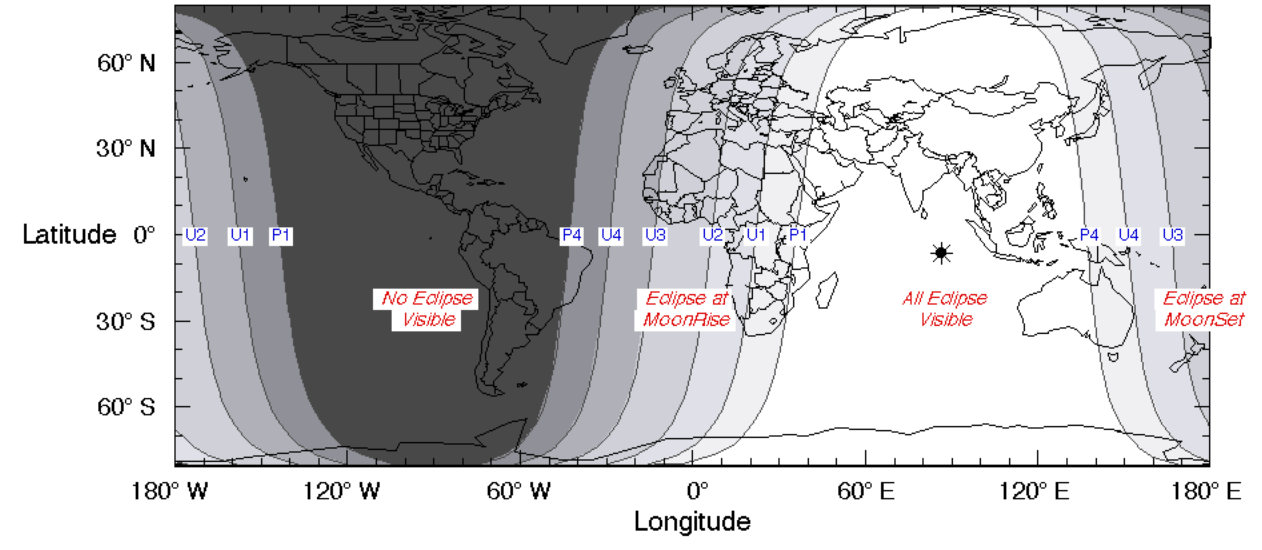Map of September 2025 Lunar Eclipse Visibility


David Chen
Data Visualization Specialist
David Chen is an expert in transforming complex geographic datasets into compelling visual narratives. He combines his background in computer science ...
Geographic Analysis
What This Map Shows
The visualization titled "Who Will See This Weekend's Lunar Eclipse" provides a clear representation of the regions around the globe where the lunar eclipse occurring on September 7, 2025, will be visible. Beginning around 15:30 UTC, this map highlights the areas that will experience the eclipse in its various phases, including totality, partial visibility, and no visibility at all. Understanding this map is crucial for astronomy enthusiasts and anyone interested in witnessing this celestial event.
Deep Dive into Lunar Eclipses
Lunar eclipses occur when the Earth comes between the Sun and the Moon, casting a shadow on the Moon's surface. Unlike solar eclipses, which require specific geographic locations for optimal viewing, lunar eclipses can be seen from anywhere on the night side of the Earth. They are categorized into three main types: total, partial, and penumbral eclipses. During a total lunar eclipse, the Moon can take on a reddish hue, often referred to as a "blood moon." This phenomenon is caused by Rayleigh scattering—the same effect that makes sunsets appear red—with light from the Sun passing through the Earth’s atmosphere and bending onto the Moon.
Interestingly, lunar eclipses can last several hours. The September 2025 eclipse will be particularly noteworthy as it will be visible in a variety of regions, including parts of North America, Europe, Africa, and western Asia. The duration of totality, where the Moon is completely within Earth's shadow, is a significant factor for those aiming to observe the eclipse fully. Typically, totality can last anywhere from a few minutes to over an hour, depending on the alignment of the Earth, Moon, and Sun.
For viewers, the eclipse presents a unique opportunity to witness a natural spectacle that has captivated humanity for centuries. From ancient civilizations that interpreted lunar eclipses as omens to modern-day scientists who study their implications on lunar geology and atmospheric conditions, these events resonate deeply within our cultural and scientific narratives.
Regional Analysis
The visibility of the September 2025 lunar eclipse varies significantly across different regions. In North America, observers in the eastern parts will enjoy prime viewing conditions, while those in the west may only see a partial eclipse. In Europe, the central and eastern countries will have an excellent vantage point, with the eclipse occurring during the evening hours. Conversely, regions further north may face challenges due to daylight at the time of the event.
Interestingly, Africa offers some of the best viewing conditions, as many countries will experience totality during the night hours. For example, nations like Egypt and South Africa will have prime positions to witness the full effect of the eclipse. Meanwhile, western Asia will also enjoy good visibility, although weather conditions may play a role in the overall experience.
This regional variability is crucial for those planning to observe the eclipse, as factors such as local weather conditions, time zones, and geographic features can affect visibility. For instance, mountainous regions may obscure the view of the horizon, while urban light pollution can diminish the clarity of the eclipse.
Significance and Impact
Lunar eclipses hold significant cultural and scientific importance. They remind us of the dynamic nature of our solar system and the interconnectedness of celestial bodies. For astronomers, studying lunar eclipses can lead to insights about the Earth's atmosphere and its effects on light. Furthermore, they serve as a valuable opportunity for educators to engage students in discussions about astronomy, physics, and the natural world.
In recent years, there has been a growing interest in celestial events, spurred by social media and public awareness campaigns. This increased enthusiasm can lead to larger gatherings for eclipse viewing, fostering a sense of community among spectators. However, it also raises questions about access to viewing sites and the environmental impact of large gatherings.
Looking towards the future, the September 2025 lunar eclipse serves as a reminder of the beauty of our universe and the importance of preserving our night skies. As light pollution increases in urban areas, the opportunity to witness such events may diminish. Encouraging awareness about light pollution and promoting dark sky initiatives could help ensure that future generations can also experience the wonder of a lunar eclipse.
In conclusion, the upcoming lunar eclipse offers a fantastic opportunity for global engagement with astronomy. Whether you're an avid skywatcher or a casual observer, knowing when and where to look can enhance your experience and deepen your appreciation for the cosmos. So mark your calendars for September 7, 2025, and prepare to gaze at the Moon as it transforms before your eyes!
Visualization Details
- Published
- September 6, 2025
- Views
- 82
Comments
Loading comments...